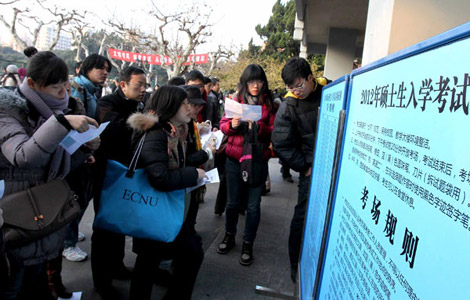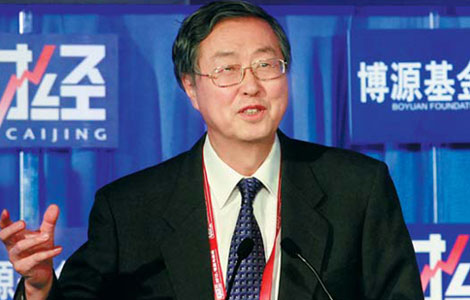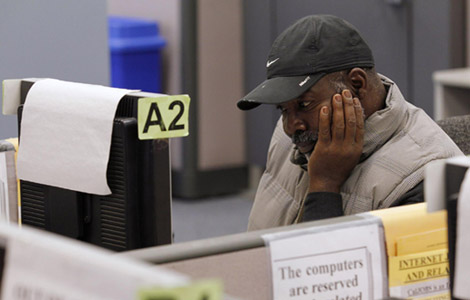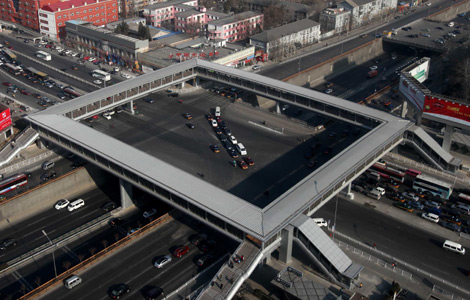China veers onto healthier course
Updated: 2012-01-07 16:50
(Xinhua)
|
|||||||||
BEIJING - China's future economic development can possibly be surmised just by looking at a stretch of the country's manufacturing plants located along two sides of a dilapidated road in eastern Zhejiang province.
This 20-meter-wide road runs through part of Taizhou, a coastal city where skilled workers from the nation's inland areas work day and night, manufacturing 45 percent of the world's sewing machines.
Founded 17 years ago, China's Zhejiang New Jack Sewing Machine Co. Ltd. has become the country's largest sewing machine producer in terms of production and sales, driven by its innovative spirit. The company's production and sales are both projected to rise by 15 percent in 2011.
Despite a 10-percent rise in costs due to higher wages and increased raw material prices, the company's profits remained at 10 percent.
Meanwhile, an electric motor technology that the company developed last year has helped it save over 20 percent in metal materials and cut users' energy consumption by 70 percent, putting its products in high demand.
"Labor-intensive sewing machine manufacturing is not a sunset industry in China. No one can replace the nation's position at least in the next 20 years because of the technological progress and innovation the sector has made," Zhao Xinqing, the company's chairman, said.
Five kilometers away from the sewing machine manufacturer, some workers were busy building two workshops for three high-tech production projects launched by Zhejiang Nanyang Technology Co., Ltd., the world's largest capacitor film producer.
"Our goal is to develop new materials and new energy sectors that support the country's enduring competitiveness," said Du Zhixi, general manager of the company, which reported a 20-percent profit rise annually over the past ten years.
These manufacturers offer a glimpse of the progress China has made in the first year of its 12th Five-Year Plan (2011-2015) period, and provide some evidence that there is no need for China to worry about a "hard landing" or even consider a "forecast of doom" in its economy.
The Chinese government has called for upgrades in the manufacturing sector and the fostering of strategically-emerging industries over the next five years -- efforts to help the country move toward being a manufacturing powerhouse and gain an edge over future global competition.
China's growth in 2011 indeed went through a continuous slowdown. Its GDP grew 9.1 percent year-on-year in the third quarter, down from 9.5 percent in the second quarter and 9.7 percent in the first quarter.
Other economic indicators also showed signs of deceleration. The Purchasing Managers' Index (PMI) rose to 50.3 in December after dropping to a 33-month low of 49 in November, underlining the difficult time the country's manufacturers have been through. (A PMI reading of 50 percent demarcates expansion from contraction.)
Meanwhile, exports, another major engine driving the country's economic growth, rose 13.8 percent year-on-year in November, down 2.1 percentage points from a month earlier. The trade surplus is expected to narrow to $160 billion in 2011, compared to $183.1 billion in 2010, according to the Ministry of Commerce.
However, this does not necessarily suggest that the world's most important growth engine has hit a red light, or that it is losing momentum. The real problem currently facing China is how the country can steer itself onto to a more healthy growth track.
Apart from the worsening Eurozone debt crisis and a weak US economy dragging down the country's exports, China's slowdown is largely the result of self-initiated macro control.
"The slowdown is moderate and controlled, and is necessary for curbing inflation and restructuring the economy. It also indicates that the country has sped up the transition from quantity-oriented growth to quality-led development," said Zhang Xiaojing, a researcher with the Chinese Academy of Social Sciences (CASS), a government think tank.
To contain runaway inflation, China's central bank has raised banks' reserve requirement ratio (RRR) 12 times to a record high of 21.5 percent since 2010 and hiked interest rates five times since October 2010. As a result, consumer prices eased to 4.2 percent in November from a 37-month high of 6.5 percent in July.
"In 2011, the country started to unveil its efforts to drive its growth mode shift. It is trying to cut reliance on investment and exports, and the moderate slowdown provides leeway to make that change," said Wen Zongyu, a researcher with the Ministry of Finance.
In the 12th Five-Year Plan, the government set its annual economic growth rate target at 7 percent over the next five years, and for the first time, the government set goals to put income growth in line with economic development.
"China has better fiscal and financial resources for avoiding a recession. But it will not again issue a stimulus plan similar to the previous 4-trillion-yuan ($634 billion) stimulus package, so there is no way for China to face a deep recession, as other developed economies have," said Wang Tongsan, also a CASS researcher.
Wang expected that the country's economy will grow 9 percent in 2011 and stay between 8 percent and 9 percent this year, while consumer price growth will be held under 4 percent.
"The year's economic growth is likely to hit the lowest since 2003, but it will still be the world's fastest among large economies," he said.
To shore up growth while avoiding retriggering inflation, the government said it will fine-tune its monetary policy in light of changes in economic development at the central economic work conference held in December, which mapped out the course of this year's economic work.
CASS researcher Zhang Yuewen expected at least a 150-basis-point cut in the RRR this year following last November's RRR cut, which was the first one in nearly three years, and that the government will release 8 trillion yuan in credit supply. "A selective loosening is a sure thing," he said.
Meanwhile, many economists hold that China's economy has the potential to maintain its current strong growth over the coming 20 years.
Given that the country's per capita income only accounted for 21 percent of the United States' as of 2008, it can continue enjoying these advantages before the gap closes up, said Lin Yifu, the World Bank's chief economist.
With urbanization barely at 50 percent and industrialization still in the middle stage, China's annual growth is likely to reach 7 percent in the next 20 years, said economists surveyed in Beijing.
Hot Topics
Kim Jong-il, Mengniu, train crash probe, Vaclav Havel, New Year, coast guard death, Internet security, Mekong River, Strait of Hormuz, economic work conference
Editor's Picks

|

|

|

|

|

|







